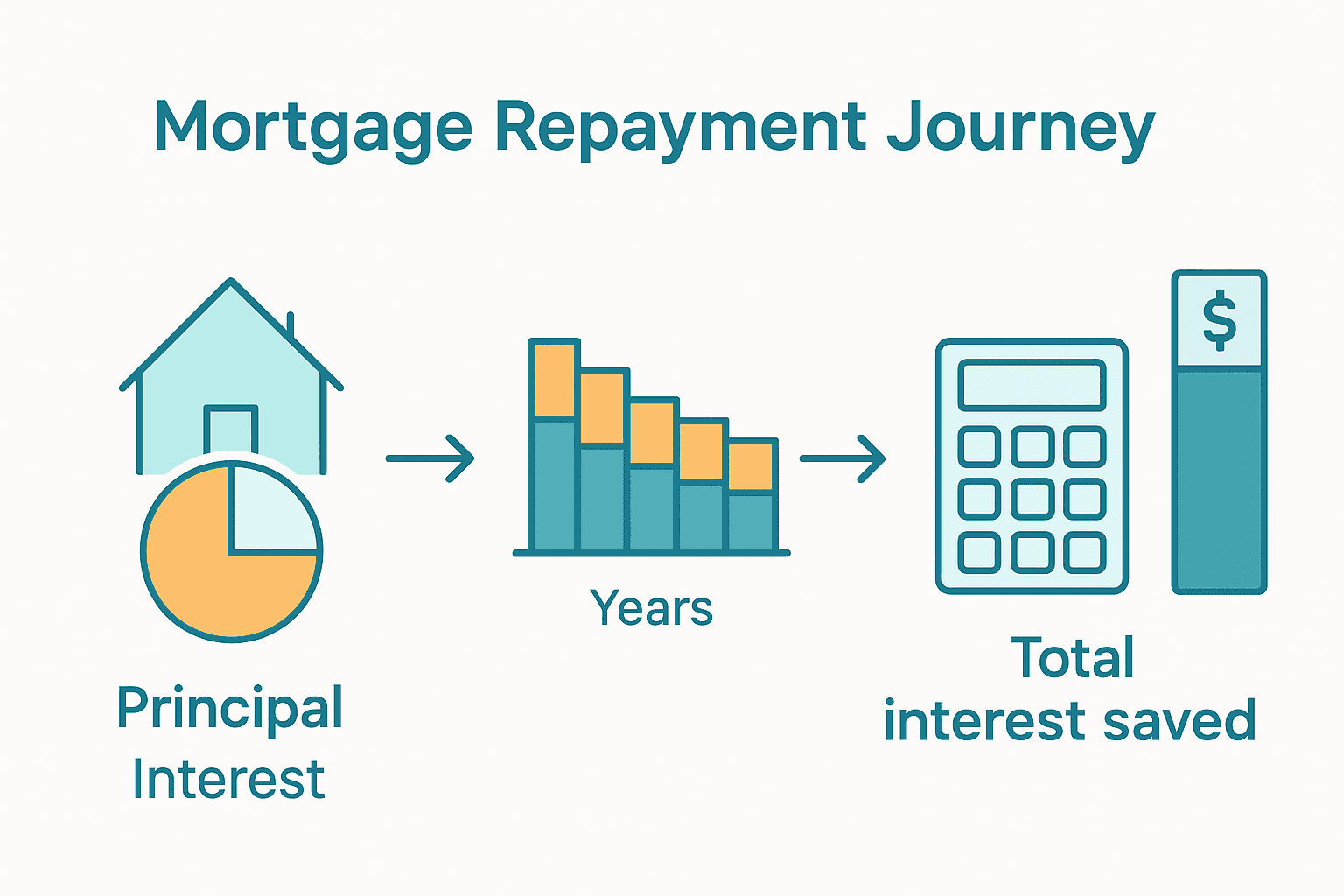Most australian homeowners are surprised to learn that more than half underestimate the true long-term cost of their mortgage repayments. Securing a loan is more than just a paperwork exercise, it shapes every aspect of your financial future. Knowing how repayments work, from principal to interest, gives you the control to make smarter choices and avoid costly mistakes that can add up over the years.
Table of Contents
- Mortgage Repayments Defined And Key Concepts
- Types Of Home Loan Repayments In NZ
- How Mortgage Interest And Principal Work
- Budgeting For Repayments And Managing Costs
- Common Pitfalls With NZ Mortgage Repayments
Key Takeaways
| Point | Details |
|---|---|
| Understanding Mortgage Repayments | Mortgage repayments consist of principal and interest, with early payments mainly covering interest. Knowledge of this structure is vital for effective loan management. |
| Types of Loan Repayment Options | Borrowers can choose between fixed-rate, variable-rate, interest-only, and other structures, impacting their financial strategy. Selecting the right type depends on personal financial circumstances. |
| Importance of Budgeting | A comprehensive budget should include more than the minimum repayment, factoring in income changes and unexpected expenses. Flexibility and contingency planning are essential for financial stability. |
| Avoiding Common Pitfalls | Overextending borrowing capacity and neglecting to build a financial buffer are key mistakes. Regularly reviewing loan terms is crucial for adapting to changing economic conditions. |
Mortgage Repayments Defined And Key Concepts
A mortgage repayment represents the regular financial commitment you make to gradually pay off your home loan, typically comprising both principal and interest components. Understanding these repayments is crucial for effectively managing your home financing strategy. When you secure a home loan, you’re essentially entering a structured agreement with a lender to progressively own your property through consistent, scheduled payments.
The core structure of mortgage repayments involves two primary elements: principal and interest. The principal is the actual amount you’ve borrowed, while interest represents the cost charged by the lender for providing the loan. In the early stages of your mortgage, a larger portion of your repayment goes towards interest, with the balance gradually shifting to cover more principal as time progresses. This mechanism, known as amortisation, ensures that by the end of your loan term, you’ll have fully repaid both the original borrowed amount and the accumulated interest.
Mortgage repayments can be structured in several ways to suit different financial circumstances. Most borrowers opt for regular monthly repayments, but options like fortnightly loan repayments can help accelerate your loan payoff. Some key variations include:
- Fixed-rate repayments: Consistent payment amounts throughout the loan term
- Variable-rate repayments: Payment amounts that can fluctuate with market interest rates
- Interest-only repayments: Temporary arrangements where you pay only the interest for a set period
Choosing the right repayment strategy requires careful consideration of your personal financial situation. Learn the importance of understanding mortgage repayments to make informed decisions that align with your long-term financial goals and current economic circumstances.
Types Of Home Loan Repayments In NZ
Navigating the landscape of home loan repayments in New Zealand requires understanding the diverse options available to borrowers. According to Simplicity, there are several distinct types of mortgage structures that can significantly impact your financial strategy and long-term loan management.
The primary types of home loan repayments in New Zealand include fixed-rate, floating-rate, revolving credit, and offset loans. Fixed-rate loans offer stability with consistent interest rates for predetermined periods, typically ranging from one to five years. These provide predictable repayment amounts, making budgeting more straightforward. Floating-rate loans, in contrast, fluctuate with market conditions, offering more flexibility but potentially higher variability in monthly payments.
Revolving credit and offset loans represent more sophisticated repayment strategies. Revolving credit loans function similarly to an everyday transaction account, allowing you to deposit your income directly and potentially reduce interest charges. Offset loans enable you to offset your loan balance against your savings account, potentially reducing the total interest payable. Explore the intricacies of choosing the right mortgage structure to determine which approach best suits your financial goals.
When selecting a home loan repayment type, consider factors such as:
- Your income stability
- Long-term financial objectives
- Potential interest rate fluctuations
- Personal risk tolerance
- Ability to make additional repayments
Each repayment structure offers unique advantages, and the optimal choice depends on your individual financial circumstances. Consulting with a mortgage professional can help you navigate these options and select the most suitable approach for your specific needs.

How Mortgage Interest And Principal Work
Mortgage interest and principal represent the two fundamental components that determine how your home loan is repaid over time. According to AIA NZ, the structure of mortgage repayments involves a complex interplay between these two elements, with each payment gradually shifting the balance between interest and principal.
In the initial stages of your mortgage, a larger proportion of each repayment goes towards paying interest, while a smaller amount reduces the principal balance. As Nectar Money explains, this mechanism means that early mortgage payments are predominantly interest-focused. The principal represents the original amount you borrowed, while interest is the cost charged by the lender for providing the loan. Over time, the ratio gradually changes, with more of each payment going towards reducing the principal as the loan matures.
The calculation of interest follows a few key principles that impact your overall repayment strategy:
- Interest is typically calculated daily and charged monthly
- The interest rate can be fixed or variable, affecting your repayment amount
- Your loan balance determines the total interest charged
- Extra repayments can significantly reduce the total interest paid over the loan term
Five strategies can help you manage your mortgage more effectively, including making additional payments, reducing the loan term, or exploring offset account options. Understanding how interest and principal interact is crucial for making informed decisions about your home loan, ultimately helping you minimise the total interest paid and build equity faster.

Budgeting For Repayments And Managing Costs
Effective mortgage budgeting requires a strategic approach that goes beyond simply tracking monthly payments. Financial planning for your home loan involves understanding your complete financial landscape, anticipating potential changes, and creating a robust framework that can adapt to shifting economic conditions.
Budgeting for mortgage repayments involves several critical considerations. Your monthly budget should allocate more than just the minimum repayment amount, creating a buffer for unexpected expenses or potential interest rate fluctuations. Key elements to factor into your mortgage budget include:
- Your current and projected household income
- Potential changes in employment or earning capacity
- Emergency fund requirements
- Other financial obligations and debt
- Potential future interest rate increases
To maintain financial stability, consider developing a comprehensive strategy that includes flexibility and contingency planning. Let’s talk about your debt and financial commitments to understand how to create a sustainable approach to managing your home loan costs. Techniques like setting up automatic repayments, maintaining a dedicated savings buffer, and regularly reviewing your loan structure can help you stay ahead of potential financial challenges.
Managing mortgage costs effectively also means being proactive about your loan’s long-term performance. This includes exploring opportunities to reduce interest payments, such as making additional repayments when possible, considering offset accounts, and periodically reviewing your loan to ensure it still meets your financial goals. Remember, a well-planned mortgage strategy can save you thousands of dollars and provide greater financial peace of mind over the life of your loan.
Common Pitfalls With NZ Mortgage Repayments
Mortgage repayment challenges can significantly impact your financial stability, and understanding potential pitfalls is crucial for New Zealand homeowners. According to Reuters, the central bank has introduced specific limits on housing finance to reduce default risks, highlighting the complex landscape of home loan management.
Some of the most critical pitfalls New Zealand borrowers encounter include:
- Overextending borrowing capacity
- Failing to account for potential interest rate fluctuations
- Neglecting to build an emergency financial buffer
- Choosing inflexible loan structures
- Ignoring the long-term implications of short-term financial decisions
Six of the biggest mistakes homeowners make with lending often stem from a lack of comprehensive financial planning. As Reuters further reports, the Reserve Bank’s ongoing adjustments to loan-to-value ratio restrictions underscore the dynamic nature of mortgage lending in New Zealand.
Navigating mortgage repayments requires a proactive approach. This means regularly reviewing your loan structure, understanding the implications of fixed versus floating rates, and maintaining financial flexibility. Borrowers should be prepared to adapt their strategy as economic conditions change, ensuring they can manage repayments even during unexpected financial challenges. The key is to approach your mortgage as a long-term financial commitment that requires ongoing attention and strategic planning.
Take Control of Your Mortgage Repayments Today
Understanding mortgage repayments and their impact on your financial future is vital but can feel overwhelming when facing fluctuating interest rates and complex loan options. This guide covers crucial concepts like principal versus interest, fixed and variable rates, and budgeting strategies designed to protect you from common pitfalls. Managing your mortgage effectively means knowing when to act and how to tailor repayments to your unique situation.

Don’t let uncertainty hold you back from achieving financial security and owning your home sooner than you imagined. As local Auckland mortgage advisers based in Hobsonville, Mortgage Managers specialise in helping you navigate these challenges with personalised advice that aligns with your goals. Discover how to optimise your repayments or explore flexible loan structures by connecting with our experts at Mortgage Managers. Ready for smarter mortgage management see how we can support you by starting the conversation with let’s talk about your debt and financial commitments and choosing the right mortgage structure. Take the first step today and lock in a strategy that reduces stress and saves you money.
Frequently Asked Questions
What are the main components of mortgage repayments?
Mortgage repayments consist of two primary components: the principal and interest. The principal is the amount you borrowed, while the interest is the cost charged by the lender for the loan. Initially, a larger portion of your payment goes towards interest, gradually shifting towards the principal over time due to amortisation.
What types of home loan repayment structures are available?
There are several types of home loan repayment structures, including fixed-rate, variable-rate, revolving credit, and offset loans. Fixed-rate loans offer consistent payments, while variable-rate loans fluctuate with market interest rates. Revolving credit allows you to manage your payments like a transaction account, and offset loans can reduce interest by offsetting your savings against your loan balance.
How does budgeting for mortgage repayments work?
Budgeting for mortgage repayments involves considering your total financial landscape, including current and projected income, emergency funds, and other financial obligations. It’s important to allocate more than just the minimum repayment amount to create a buffer for unexpected expenses or changes in interest rates.
What common pitfalls should borrowers avoid?
Common pitfalls include overextending borrowing capacity, failing to account for interest rate fluctuations, neglecting to build an emergency financial buffer, and choosing inflexible loan structures. It’s crucial to regularly review your loan and maintain financial flexibility to manage repayments effectively.
